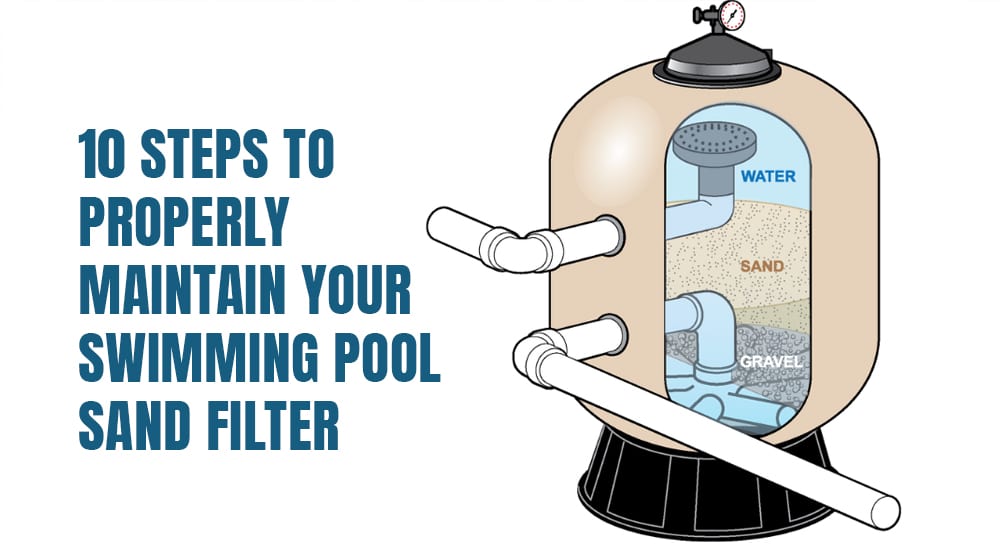Swimming pool sand filters are vital to any pool’s filtration system, keeping the water clean, clear, and safe for swimmers. Proper maintenance ensures your sand filter functions efficiently, extends its lifespan, and minimizes the need for costly repairs. This guide outlines ten essential steps to effectively maintain your swimming pool sand filter.
What is a Swimming Pool Sand Filter?
A swimming pool sand filter uses specially graded sand to trap dirt, debris, and impurities from the water. As pool water passes through the filter, particles are captured in the sand bed, allowing clean water to flow back into the pool. Sand filters are highly efficient and require relatively low maintenance compared to other filtration systems. However, regular upkeep is essential to keep these swimming pool filters working optimally.
Step 1: Regularly Check and Clean the Filter Basket
Why It’s Important
The filter basket traps large debris like leaves and twigs, preventing them from clogging the sand filter.
How to Clean the Filter Basket
- Turn off the pool pump.
- Remove the basket from the filter housing.
- Empty debris and rinse the basket with a hose.
Tips
- Clean the basket weekly to prevent buildup.
- Inspect for cracks or damage and replace if necessary.
Step 2: Inspect and Replace the Sand
Why It’s Important
Over time, sand becomes worn and less effective at trapping debris.
How to Inspect and Replace Sand
- Check for signs of clumping or wear, such as reduced filtration efficiency.
- Replace sand every 3-5 years, or as recommended by the manufacturer.
- Use the correct amount and type of sand specified for your filter.
Step 3: Backwash the Filter
Why It’s Important
Backwashing removes trapped debris and restores the filter’s efficiency.
How to Backwash
- Turn off the pump and set the valve to “Backwash.”
- Turn the pump on and watch the sight glass until the water runs clear.
- Return the valve to the “Filter” setting
Tips
- Backwash once a week or when the pressure gauge indicates a 7-10 psi increase.
Step 4: Check and Adjust the Valve Settings
Why It’s Important
Proper valve settings ensure optimal filtration and prevent damage.
How to Adjust Valve Settings
- Familiarize yourself with the multiport valve positions (e.g., Filter, Backwash, Rinse).
- Periodically inspect the valve for smooth operation and leaks.
Step 5: Inspect the Filter’s O-Rings and Gaskets
Why It’s Important
O-rings and gaskets create a watertight seal, preventing leaks.
How to Inspect and Replace
- Check for cracks, wear, or hardening.
- Apply silicone lubricant to maintain flexibility.
- Replace damaged O-rings and gaskets promptly.
Step 6: Clean the Filter’s Exterior
Why It’s Important
Keeping the exterior clean prevents corrosion and buildup that can affect performance.
How to Clean
- Wipe the exterior with a damp cloth and mild detergent.
- Remove dirt and debris from vents and crevices.
Tips
- Avoid abrasive cleaners that can damage the surface.
Step 7: Check the Filter’s Pressure Gauge
Why It’s Important
The pressure gauge indicates the filter’s performance and alerts you to potential issues.
How to Check and Interpret
- Read the gauge regularly; normal operating pressure varies by system.
- Investigate sudden increases or decreases in pressure.
Step 8: Perform Regular Chemical Cleaning
Why It’s Important
Chemical cleaning removes oils, grease, and fine particles that backwashing cannot eliminate.
How to Perform Chemical Cleaning
- Use a filter cleaning solution recommended by the manufacturer.
- Follow safety guidelines and wear gloves while handling chemicals.
Step 9: Monitor the Filter’s Performance
Why It’s Important
Regular monitoring ensures the filter functions efficiently and identifies issues early.
How to Monitor
- Track flow rates and pressure readings weekly.
- Look for signs of reduced water clarity or performance issues.
Step 10: Schedule Professional Maintenance
Why It’s Important
Professional technicians can identify and resolve issues that DIY maintenance may overlook.
How to Schedule Maintenance
- Hire a qualified pool technician with experience in sand filter systems.
- Schedule inspections annually or as recommended.
Conclusion
Maintaining your swimming pool sand filter is essential for clean, safe, and enjoyable swimming. By following these ten steps, you can extend the life of your filter, save money on repairs, and ensure optimal pool performance.
For premium sand filters and expert pool solutions, choose Blue Storm International – the leading pool equipment supplier in Muscat. Blue Storm ensures your pool stays in excellent condition year-round with top-quality products and professional services. Contact them today!
